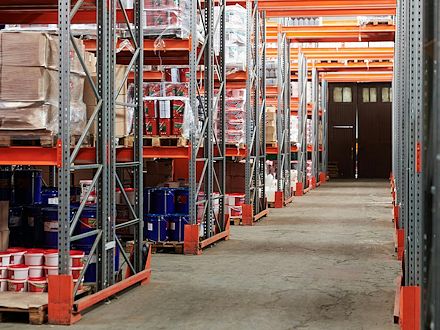
A pallet racking system, also called an industrial pallet rack, is a metal structure designed to store palletized loads vertically. It optimizes floor space and facilitates handling with forklifts, offering direct or semi-direct access to stored goods.
A racking system consists of upright frames, horizontal beams, bracings, base plates, and safety accessories (corner guards, mesh panels, guardrails). The design must consider load per level, dynamic forces from forklifts, and the building’s structural limits.
Operating Principles: FIFO, LIFO, and FEFO
Depending on product characteristics and stock rotation strategy, several storage logics are used:
- FIFO (First In, First Out) — the first pallet stored is the first retrieved; ideal for perishable goods.
- LIFO (Last In, First Out) — the last pallet stored is the first retrieved; common in compact systems.
- FEFO (First Expired, First Out) — the earliest expiring pallet is shipped first; suited for dated products.
Main Types of Pallet Racking
Selective Racking
The most common configuration: each pallet is directly accessible. It provides flexibility but requires multiple aisles, thus more floor space.
Drive-In / Drive-Through Racking
Pallets are stored one behind another on rails. In drive-in systems, forklifts load and unload from the same side (LIFO). In drive-through systems, loading and unloading occur from opposite sides (FIFO). High-density solution, but handling precision is required.
Dynamic Racking (Gravity Flow / Push-Back)
Pallets move on inclined roller tracks from loading to unloading points. Gravity flow systems operate on FIFO; push-back systems follow LIFO, where each pallet pushes the previous one. These combine storage density with rotation efficiency but require braking rollers and regular inspection.
Mobile Racking
Racks are mounted on motorized carriages that move on rails. Only one working aisle is open at a time, optimizing available space. Ideal for cold storage or limited-space facilities, but costly and demanding in floor flatness.
Automated Racking (AS/RS)
In high-bay warehouses, automated storage and retrieval systems (AS/RS) use stacker cranes or shuttles to move pallets based on FIFO, LIFO, or FEFO strategies. These require a warehouse management system (WMS) and specialized infrastructure.
Load Capacity and Structural Considerations
Load capacity depends on the pallet weight, number of levels, beam and upright strength, and safety standards. Typical beam levels support 1,000–3,000 kg each. Heavy-duty racks can handle higher loads with reinforced profiles and bracing.
The warehouse floor must bear static and dynamic loads. Load distribution plates may be required to reduce ground pressure under base plates.
Indoor / Outdoor and Heavy-Duty Racking
Indoor racking mainly depends on ceiling height and forklift maneuvering space. Outdoor systems must account for corrosion, wind, snow, and rain. Galvanized steel and weatherproof coatings are recommended; roofing or cladding may be added for sensitive goods.
Pallet Drawers
Pallet drawers (sliding trays) allow full extraction of pallets without entering the aisle. They improve ergonomics and safety by reducing forklift collisions with racks. Available in manual or motorized versions, they’re ideal for picking and preparation zones.
Installation Requirements
- Ceiling height — allow for lighting, ducts, and forklift lifting clearance.
- Floor strength — verify slab load capacity and use spreader plates if necessary.
- Aisle width — adjust to forklift turning radius and load dimensions.
- Clearances — maintain 25–100 mm gaps for easy pallet handling and safety.
- Anchoring and stability — follow manufacturer guidelines; secure all uprights to the floor.
- Regulations and inspections — maintain inspection logs and perform periodic safety checks.
Safety and Protection
Safety equipment includes upright guards, column protectors, anti-fall mesh, pedestrian barriers, and dynamic system brakes. Operator training and regular inspections are critical to prevent collapse and accidents caused by overloads or impacts.
Sample Calculation Sheet (Methodology and Example)
Below is a simplified example of a spreadsheet method for checking beam deflection and load capacity.
Assumptions
- Number of levels (excluding ground): 3
- Load per pallet: 1,500 kg
- Span between uprights (L): 2.50 m (2,500 mm)
- Beams per level: 2
- Safety factor: 1.5
- Allowable deflection: L / 200
Step 1 — Maximum Allowable Deflection
δmax = L / 200 = 2,500 mm / 200 = 12.5 mm
Step 2 — Design Load per Level
1,500 × 1.5 = 2,250 kg total per level.
Step 3 — Load per Beam
2,250 / 2 = 1,125 kg per beam.
Step 4 — Beam Deflection Check
Deflection formula for a simply supported beam under uniform load:
δ = (5/384) × (q × L⁴) / (E × I)
- q = distributed load (N/mm)
- E = steel modulus ≈ 210,000 N/mm²
- I = moment of inertia of beam section (mm⁴)
Ensure δ ≤ δmax; otherwise, increase beam section or reduce span.
Step 5 — Upright Check (Buckling)
Uprights must be verified for buckling based on unbraced length and anchorage. Ground pressure must remain within slab load limits.
Simplified Summary Table
| Level | Useful Load (kg) | Safety Factor | Design Load (kg) | Load per Beam (kg) |
|---|---|---|---|---|
| 1 | 1,500 | 1.5 | 2,250 | 1,125 |
| 2 | 1,500 | 1.5 | 2,250 | 1,125 |
| 3 | 1,500 | 1.5 | 2,250 | 1,125 |
Note: This example is simplified. Real-world design must include dynamic effects, load distribution, and profile geometry (I, section modulus, etc.). Final validation should be done by the manufacturer’s engineering department or a structural engineer.
Purchase pallet shelving
Choosing the right pallet racking system depends on product type, logistics flow, available space, and budget. Proper engineering, installation, and maintenance ensure warehouse safety and efficiency.
Rayonnalp, the industrial racking specialist in the Rhône-Alpes region, designs, installs, and inspects all types of pallet storage systems. From on-site audits to installation and safety compliance, Rayonnalp provides complete technical and regulatory support.
[ Back ]
